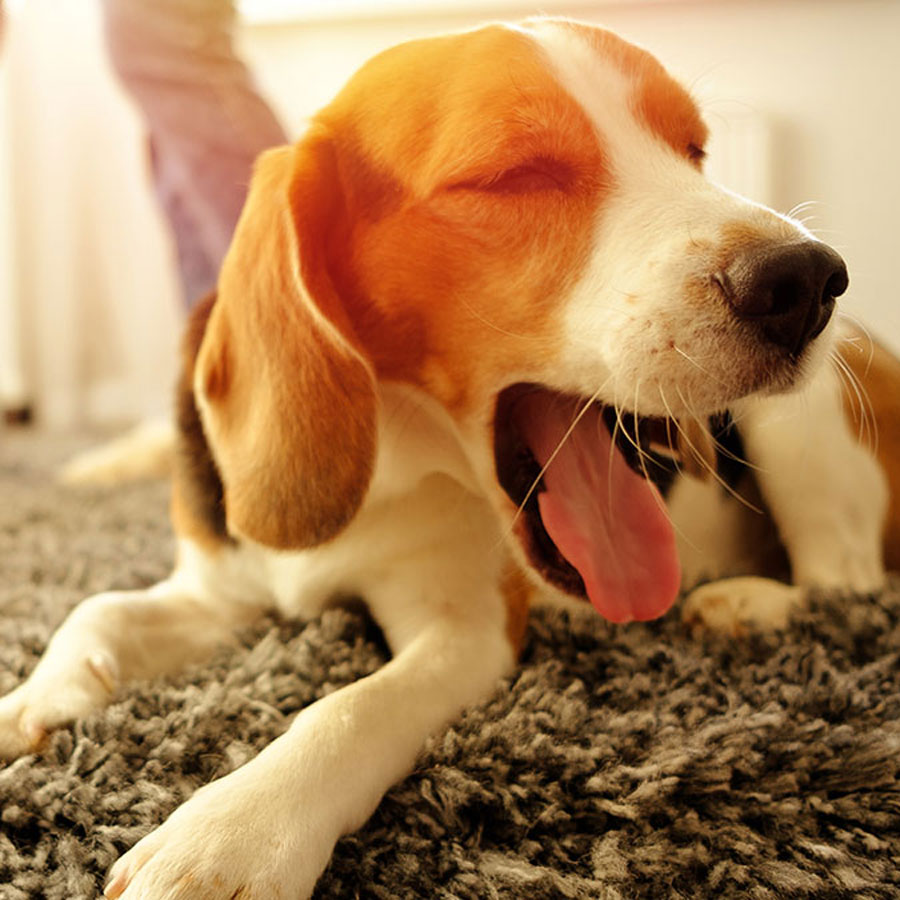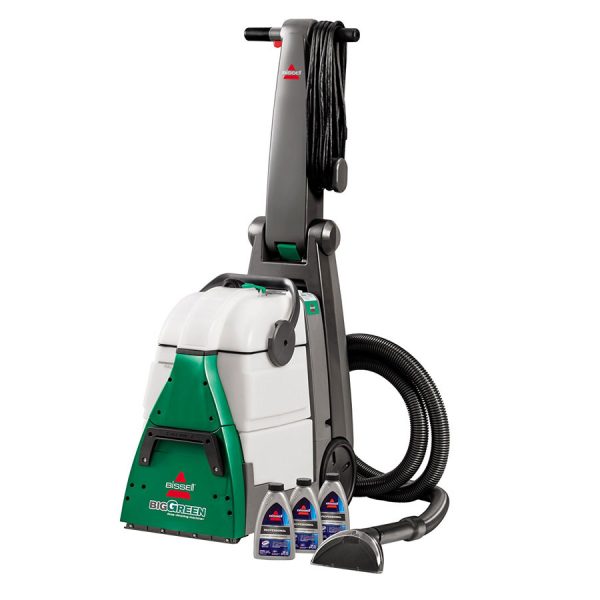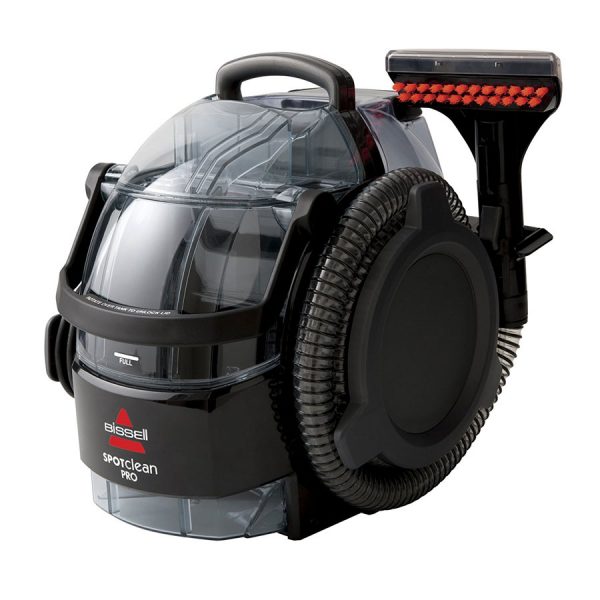From muddy paws and grass stains to hair clumps, there are numerous pet-related reasons to clean your carpet, but have you ever thought about whether carpet cleaners can make a dog sick?
Like most household cleaning solutions, a carpet cleaner can make a dog sick.
Most carpet cleaners contain chemicals toxic to dogs. These chemicals include glycol ethers, bleach, bleach, and formaldehyde. However, even eco-friendly, natural cleaners aren’t risk-free.
You should be aware of household cleaner poisoning symptoms in dogs and how to react if your dog accidentally drinks the liquid. Note that even inhalation or skin exposure can have consequences.
The good news is that not all carpet cleaners are the same. Some solutions are safe for pets, so consider trying them first unless your carpet is severely stained.
Glycol Ethers
Glycol ethers are a common ingredient in home-use and professional carpet cleaning solutions. You can identify these solvents by names like “propylene glycol,” “diethylene glycol,” and “ethylene glycol.” All glycol ethers are highly toxic to dogs and other pets.
Many dogs are attracted to glycol ethers because of their sweet taste, so cases of dogs drinking antifreeze or carpet cleaning solutions aren’t uncommon. Unfortunately, even a tiny amount of the liquid can result in severe poisoning.
According to veterinarians, even half a teaspoon of ethylene or propylene glycol is toxic to dogs and can result in fatality. If your dog drank carpet cleaning solution, watch out for glycol ether poisoning symptoms.
Within 30 minutes of ingestion, the dog might start showing signs of lethargy, incoordination, excessive thirst and urination, hypothermia, vomiting, and seizures, depending on the poisoning severity.
At stage two, which lasts between 12 and 24 hours of ingestion, the dog might show some improvement. Some symptoms will resolve, giving the owner a false sense of security. However, the dog develops an elevated breathing and heart rate.
About 36 hours from ingestion, the dog develops kidney dysfunction. The symptoms include swollen and painful kidneys, difficulty urinating, depression, lethargy, lack of appetite, vomiting, seizures, and coma. Kidney dysfunction is often fatal.
Bring your dog to the vet immediately if you notice any symptoms of glycol ether toxicity. Timely treatment is essential because the toxin will continue absorbing into the dog’s bloodstream until you seek help.
Veterinarians confirm glycol ether poisoning in dogs by measuring its concentration in the blood. Peak glycol levels are identified within the first six hours of ingestion. A later test can give you a false negative result.
Ammonia
Ammonia is another common ingredient in carpet cleaning solutions that is very dangerous to your dog. You can also find ammonia in hardwood, window, and stainless steel cleaners.
Ammonia is a volatile chemical that causes respiratory system problems and is highly irritating to the skin, eyes, and gastroenteric tract.
Ammonia poisoning symptoms in dogs include vomiting, diarrhea, increased thirst, lethargy, difficulty breathing, drooling, coughing, seizures, and coma.
Without treatment, ammonia poisoning in dogs leads to death, so you should bring your pet to the vet as soon as possible if you notice any symptoms. The good news is that the ammonia smell is pungent, and your dog is unlikely to drink much.
The first symptoms usually develop within several hours of ingesting the substance. How long the symptoms will last or how soon death will occur depends on the amount of ammonia your dog ingests.
If your dog drank ammonia, remove it from the area of exposure immediately and cover its nose and mouth with a wet towel to prevent further inhalation. Then, transport it to an emergency clinic where a veterinarian will take a blood test.
Don’t induce vomiting yourself because ammonia might burn the esophagus. Instead, give your dog a significant amount of water.
Home-Use vs. Professional Solutions
Any carpet cleaning solution is toxic to dogs because it contains many chemicals. However, professional carpet cleaning solutions are typically more concentrated and pose a greater threat to your dog.
Some professional carpet cleaning solutions might even contain chemicals restricted for commercial cleaners because they are dangerous to humans and must be handled correctly.
If you’ve hired professional carpet cleaners, keep your dog as far as possible away until the cleaning is finished and some hours afterward. Some professional carpet cleaning solutions are so potent your dog doesn’t even need to drink them.
Often, even inhalation of toxic fumes leads to vomiting, coughing, difficulty breathing, drooling, and other symptoms of household cleaner poisoning in dogs.
Whenever you clean your carpet or hire the pros, close your dog in a separate room or have someone walk with it. This way, you drastically reduce the risk of carpet cleaner exposure.
Are All Carpet Cleaners Equally Dangerous?
Although most carpet cleaning solutions are dangerous for your dog, they aren’t equal. Many commercial and DIY pet-safe carpet cleaning solutions won’t make your dog sick or will only cause mild symptoms like stomach upset.
Consider using simple steam vacuuming instead of chemical solutions. Steam effectively kills bacteria and refreshes the look of your carpet by lifting surface-level dust and fur without posing a threat to your dog.
If there are some stains on the carpet, consider using pet-friendly cleaning solutions containing water, cane sugar, and plant extracts. Such cleaners might not be as effective as concentrated chemical solutions but will do the job for fresh stains.
Choosing a pet-friendly carpet cleaner is simple – most are explicitly advertised as “eco” or “pet-safe.” Still, you should check the ingredient label for ammonia, bleach, glycol ethers, and other potentially dangerous substances.
If you need to get rid of persistent stains like grass or red wine, try alternative solutions first. For example, use vinegar, dish soap, or salt. If these remedies don’t help, get a chemical carpet cleaning solution, but ensure it’s safe for pets once dry.
Some carpet cleaning solutions continue to emanate toxic fumes after application. “Pet-safe” doesn’t necessarily mean you can spray the cleaner directly on your dog or let it drink but rather that the liquid is safe if used according to the manufacturer’s instructions.
Spot cleaners are also helpful because you don’t have to move furniture and clean the entire carpet to get rid of a stain. And since you work in a limited area, the risk of household cleaner poisoning is much lower.
Symptoms Of Poisoning
Even if you use an eco-friendly carpet cleaning liquid, you should know the symptoms of household cleaner poisoning in dogs. The symptoms can be mild with light exposure or extreme, sometimes leading to death.
A dog that has inhaled carpet cleaning solution might experience difficulty breathing, coughing, watery eyes, wheezing, thirst, lethargy, and shock. The symptoms are usually more severe if a dog has ingested the solution.
Ingesting a carpet cleaning solution leads to vomiting, diarrhea, increased thirst and urination, inflammation of the oral cavity, inflammation of the gastroenteric tract, and drooling.
If the cleaner has got on your dog’s skin, it will appear red and swollen. In extreme cases, the cleaner might cause hair loss and burn.
If you notice any of the above-mentioned symptoms, bring your dog to the vet immediately, even if they are mild. Timely treatment is key to preventing lasting consequences and death.
The vet will conduct a complete blood count as well as any specific tests necessary to identify a particular chemical. The treatment depends on whether the dog has ingested, inhaled, or was otherwise exposed to the chemical.
Typically, treatment of household cleaner poisoning in dogs includes intravenous fluids, pain medication, anti-inflammatory drugs, antibiotics, topical ointments, and flushing. In severe cases, the dog might need a tube in its stomach to enable the healing of the gastroenteric tract.
If you provide your dog with timely veterinary help, the treatment prognosis is positive. Often, there are no lasting consequences. However, if the poisoning was severe, your dog might have aspiration pneumonia or gastroenteric problems even after treatment.
How To Prevent Poisoning
Now that you know how dangerous carpet cleaners are for dogs, you should learn how to prevent household cleaner poisoning in pets.
Firstly, keep your cleaning solutions away from your dog’s feeding or sleeping area, behind closed doors. Ensure that your dog can’t easily open the door. Preferably, all cleaners should be up high, out of your dog’s reach.
Never keep cleaning solutions out in the open – for example, on your bathroom floor. Dogs are curious creatures and like to bite things, so your pet might accidentally open the bottle and drink the liquid.
Secondly, pick pet-friendly cleaners whenever possible. Contrary to common misconception, pet-friendly cleaners can be very effective and deal with persistent stains equally well as chemical cleaners.
Thirdly, always keep your dog away from the cleaning area, even if the cleaning solution is pet-friendly. Sometimes, inhaling the cleaner is enough to experience poisoning symptoms.
Wait until the carpet is fully dry before letting your dog in. If you hire professional carpet cleaners, warn them you have a dog and ask for any special instructions – for example, how long to wait until the solution becomes pet-safe.
Sources
- www.dogsnaturallymagazine.com/cleaning-supplies-killing-your-dog-pet-safe-cleaners/
- www.thekennelclub.org.uk/health-and-dog-care/health/health-and-care/a-z-of-health-and-care-issues/poisons-in-your-cleaning-cupboard/
- www.petpoisonhelpline.com/uncategorized/household-cleaning-products-and-your-pet-what-you-should-know-about/
- www.thesprucepets.com/best-carpet-cleaner-solutions-for-pets-4174466
- wagwalking.com/condition/household-cleaners-poisoning
- www.thespruce.com/steam-cleaning-professional-vs-diy-2908776
- animalfactstoday.com/dog-drank-ammonia/
- www.yummypets.com/mag/2018/02/09/111363/dog-poisoning
- www.petpoisonhelpline.com/poison/propylene-glycol/
- vcahospitals.com/know-your-pet/ethylene-glycol-poisoning-in-dogs


